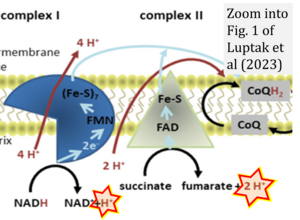Luptak 2023 Antioxidants (Basel)
| Ľupták M, Fišar Z, Hroudová J (2023) Different effects of SSRIs, Bupropion, and Trazodone on mitochondrial functions and monoamine oxidase isoform activity. Antioxidants (Basel) 12:1208. https://doi.org/10.3390/antiox12061208 |
Luptak M, Fisar Z, Hroudova J (2023) Antioxidants (Basel)
Abstract: Mitochondrial dysfunction is involved in the pathophysiology of psychiatric and neurodegenerative disorders and can be used as a modulator and/or predictor of treatment responsiveness. Understanding the mitochondrial effects of antidepressants is important to connect mitochondria with their therapeutic and/or adverse effects. Pig brain-isolated mitochondria were used to evaluate antidepressant-induced changes in the activity of electron transport chain (ETC) complexes, monoamine oxidase (MAO), mitochondrial respiratory rate, and ATP. Bupropion, escitalopram, fluvoxamine, sertraline, paroxetine, and trazodone were tested. All tested antidepressants showed significant inhibition of complex I and IV activities at high concentrations (50 and 100 µmol/L); complex II + III activity was reduced by all antidepressants except bupropion. Complex I-linked respiration was reduced by escitalopram >> trazodone >> sertraline. Complex II-linked respiration was reduced only by bupropion. Significant positive correlations were confirmed between complex I-linked respiration and the activities of individual ETC complexes. MAO activity was inhibited by all tested antidepressants, with SSRIs causing a greater effect than trazodone and bupropion. The results indicate a probable association between the adverse effects of high doses of antidepressants and drug-induced changes in the activity of ETC complexes and the respiratory rate of mitochondria. In contrast, MAO inhibition could be linked to the antidepressant, procognitive, and neuroprotective effects of the tested antidepressants.
• Bioblast editor: Gnaiger E • O2k-Network Lab: CZ Prague Fisar Z
Hydrogen ion ambiguities in the electron transfer system
Communicated by Gnaiger E (2023-10-08) last update 2023-11-10
- Electron (e-) transfer linked to hydrogen ion (hydron; H+) transfer is a fundamental concept in the field of bioenergetics, critical for understanding redox-coupled energy transformations.
- However, the current literature contains inconsistencies regarding H+ formation on the negative side of bioenergetic membranes, such as the matrix side of the mitochondrial inner membrane, when NADH is oxidized during oxidative phosphorylation (OXPHOS). Ambiguities arise when examining the oxidation of NADH by respiratory Complex I or succinate by Complex II.
- Oxidation of NADH or succinate involves a two-electron transfer of 2{H++e-} to FMN or FAD, respectively. Figures indicating a single electron e- transferred from NADH or succinate lack accuracy.
- The oxidized NAD+ is distinguished from NAD indicating nicotinamide adenine dinucleotide independent of oxidation state.
- NADH + H+ → NAD+ +2{H++e-} is the oxidation half-reaction in this H+-linked electron transfer represented as 2{H++e-} (Gnaiger 2023). Putative H+ formation shown as NADH → NAD+ + H+ conflicts with chemiosmotic coupling stoichiometries between H+ translocation across the coupling membrane and electron transfer to oxygen. Ensuring clarity in this complex field is imperative to tackle the apparent ambiguity crisis and prevent confusion, particularly in light of the increasing number of interdisciplinary publications on bioenergetics concerning diagnostic and clinical applications of OXPHOS analysis.
Labels: MiParea: Respiration, Pharmacology;toxicology Pathology: Neurodegenerative
Organism: Pig Tissue;cell: Nervous system Preparation: Isolated mitochondria, Oxidase;biochemical oxidation Enzyme: Complex I, Complex II;succinate dehydrogenase, Complex IV;cytochrome c oxidase
Pathway: N, S, CIV, NS
HRR: Oxygraph-2k



